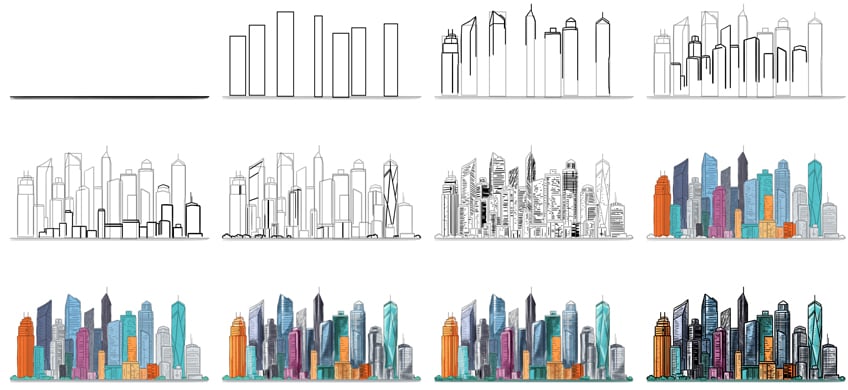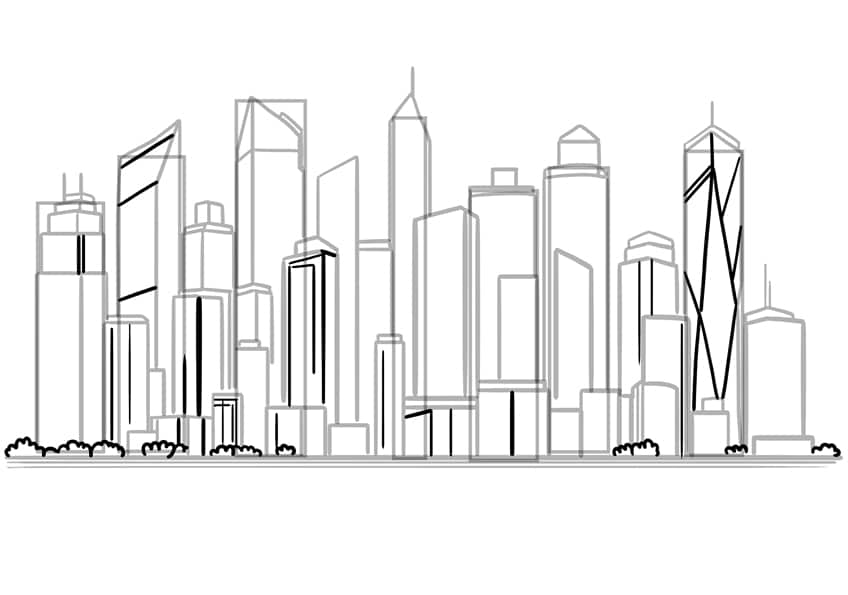How to Draw a Cityscape – Drawing the Urban Jungle
Welcome to our concise tutorial on crafting a cityscape. This guide is structured into 12 easy-to-follow steps designed to walk you through the process of creating vivid and compelling urban landscapes. Whether you’re a budding artist, an aspiring writer, or someone interested in urban design, this tutorial will provide you with the essential tools and techniques to bring your cityscapes drawing to life. Let’s dive into the art of urban portrayal and unleash the potential of your creative endeavors.
Table of Contents
- 1 From Skyline to Sketch: Capturing the Essence of a Cityscape
- 1.1 Step 1: Start to Draw the Foreground
- 1.2 Step 2: Draw the Main Buildings on Your Cityscape Drawing
- 1.3 Step 3: Outline the Main Skyscraper Buildings
- 1.4 Step 4: Add in the Mid Buildings to Your Cityscapes Building
- 1.5 Step 5: Continue to Draw the Lower Buildings
- 1.6 Step 6: Draw the Remaining Guidelines
- 1.7 Step 7: Enhance the Buildings
- 1.8 Step 8: Color the Buildings in Your Cityscapes Drawing
- 1.9 Step 9: Add Color to the Trees
- 1.10 Step 10: Shade and Highlight Your Cityscape Drawing
- 1.11 Step 11: Continue With the Shading Process
- 1.12 Step 12: Finalize Your Cityscape Drawing
- 2 Frequently Asked Questions
From Skyline to Sketch: Capturing the Essence of a Cityscape
This collage serves as a visual manual, showcasing each phase leading up to the completed sketch. By following this sequence, you will master the technique of learning how to draw a cityscape!

Step 1: Start to Draw the Foreground
Begin our how to draw a cityscape tutorial, by drawing several closely attached horizontal lines to represent the foundation layer of the city.

Step 2: Draw the Main Buildings on Your Cityscape Drawing
Begin by drawing several tall rectangles at different widths and heights to represent the main buildings on the stretch of foreground previously drawn.

Step 3: Outline the Main Skyscraper Buildings
Using the construction lines you’ve drawn earlier, start delineating the main structures, forming the distinct silhouettes of the skyscrapers.

Step 4: Add in the Mid Buildings to Your Cityscapes Building
In front of the main skyscrapers now draw the medium-length buildings, these too should be uniquely shaped and vary in height and width.

Step 5: Continue to Draw the Lower Buildings
Draw the lower section buildings between the mid and main buildings, these too should be different lengths and widths.

Step 6: Draw the Remaining Guidelines
Detail a variety of the buildings by drawing several structural lines to enhance the building shapes, this can consist of diagonal lines, vertical and horizontal lines. Continue by drawing trees in the foreground.

Step 7: Enhance the Buildings
Draw fine, horizontal lines across each building to depict the multitude of windows or glass panels. Feel free to vary the design by incorporating vertical or angled lines as well.

Step 8: Color the Buildings in Your Cityscapes Drawing
Utilize a fine, sharp brush and an assortment of colors to evenly paint each building. In this instance, we employed shades of teal, dark teal, orange, purple, blue, light gray, gray, light orange, and black.

Step 9: Add Color to the Trees
Using the same brush and teal-green paint, evenly coat the trees. Continue with gray paint and evenly coat the foreground.

Step 10: Shade and Highlight Your Cityscape Drawing
Begin with a small, soft brush and black paint for light shading on each building’s edges, keeping the first coat visible. Utilize a blending brush to soften the shading. Then, add soft highlights with white paint, blending them to finish.

Step 11: Continue With the Shading Process
Using a small, soft brush and black paint, gently shade the interiors of each tree and the foreground. Then, replicate this step with white paint to introduce gentle highlights.

Step 12: Finalize Your Cityscape Drawing
Utilize a fine, sharp brush and black paint to meticulously outline the skyscrapers and add any internal details or texture lines, including those of the trees. You have now reached the end of our how to draw a city skyline tutorial!

Congratulations on completing your journey through the intricate process on how to draw a city skyline! You’ve mastered the art of capturing the essence of urban landscapes, from the towering skyscrapers to the subtle textures of trees. This accomplishment marks a significant milestone in your artistic journey, showcasing your dedication and skill. As you move forward, remember the techniques and insights you’ve gained here. May they serve as a foundation for your future creations, inspiring you to explore new horizons and bring your unique visions to life. Well done!
Frequently Asked Questions
What Are the Essential Steps for Drawing a Simple Cityscape?
To draw a basic cityscape, I start by outlining the horizon and basic shapes of buildings with light pencil strokes. Then, I add details like windows and rooftops, focusing on perspective to create depth. Adding landmarks and shading brings the scene to life. You can follow along on our tutorial on how to draw a cityscape for more detailed steps.
How Can I Add Depth and Perspective to My Cityscape Drawings?
Adding depth involves techniques like atmospheric perspective and attention to vanishing points. I also use foreground elements and varying line weights to enhance the sense of depth in my cityscapes. Our tutorial on how to draw a skyline will give you all the necessary tips and tricks you need.
Matthew Matthysen is an educated multidisciplinary artist and illustrator. He successfully completed his art degree at the University of Witwatersrand in South Africa, majoring in art history and contemporary drawing. The focus of his thesis was to explore the philosophical implications of the macro and micro-universe on the human experience. Matthew uses diverse media, such as written and hands-on components, to explore various approaches that are on the border between philosophy and science.
Matthew organized various exhibitions before and during his years as a student and is still passionate about doing so today. He currently works as a freelance artist and writer in various fields. He also has a permanent position at a renowned online gallery (ArtGazette) where he produces various works on commission. As a freelance artist, he creates several series and successfully sells them to galleries and collectors. He loves to use his work and skills in various fields of interest.
Matthew has been creating drawing and painting tutorials since the relaunch in 2020. Through his involvement with artincontext.org, he has been able to deepen his knowledge of various painting mediums. For example, watercolor techniques, calligraphy and lately digital drawing, which is becoming more and more popular.
Learn more about Matthew Matthysen and the Art in Context Team.









